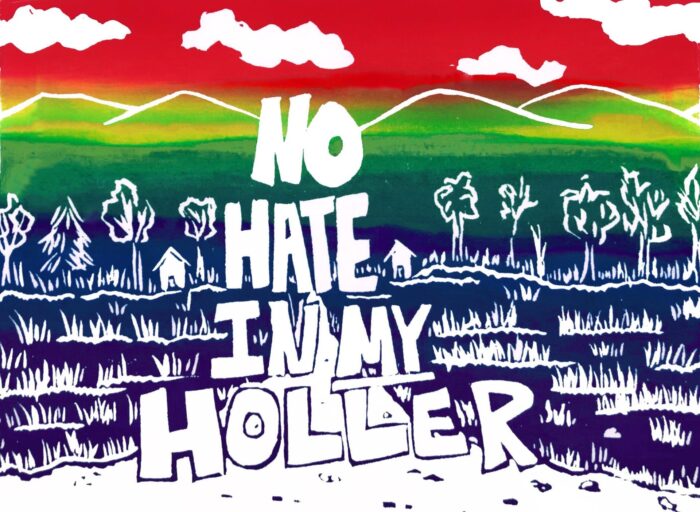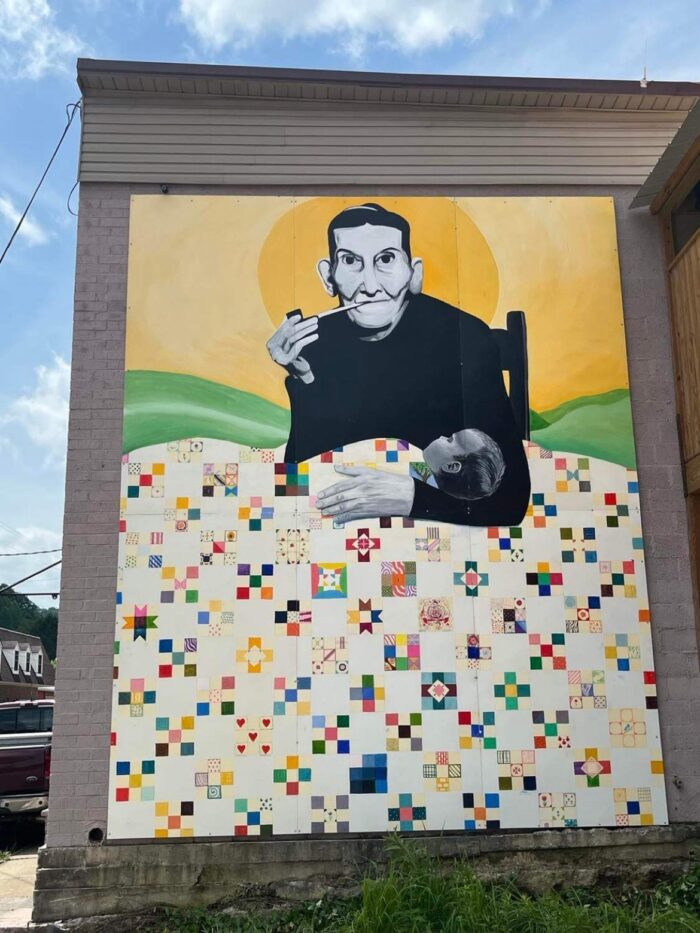Player FM 앱으로 오프라인으로 전환하세요!
Kentucky Artist Behind ‘No Hate In My Holler’ Debuts A Mural Featuring A Town’s Legendary Midwife
Manage episode 434449646 series 2471658
This conversation originally aired in the August 5, 2022 episode of Inside Appalachia.
A mural in Pound, Virginia, depicts Nancy Mullins Shores — a longtime midwife who delivered many of the town’s residents in the 20th century.
The mural was designed and painted by Lacy Hale, an eastern Kentucky artist known for painting murals across central Appalachia, including one that garnered controversy for its imagery of an opossum amid pokeweed.
Hale is probably best known for “No Hate in My Holler,” a screenprint she designed in 2017 that has spread across Appalachia on TV shirts, tote bags and even billboards.

This interview has been edited for length and clarity.
Hale: We had several community meetings to see what the projects were going to be about. And Granny Shores kept coming up: Granny Shores, Granny Shores. I found out that she was a midwife in the very early days of Pound who delivered over 1,000 babies. She was born in 1867 and she passed away in 1945. Her husband was a doctor and she went apparently to some of his appointments with him. That's how she kind of got into becoming a midwife. She boasted that she never lost a mother and she lost very few babies. Basically everybody early on in Pound, Virginia, was delivered by this woman, Granny Shores.
Adams: In this Granny Shores mural, you see her, but a lot of it's dominated by this very prominent quilt. Can you tell me more about that?
Hale: Whenever I do a piece of public art, if I'm working with the community, I want the community to be involved. I cut all these pieces of polytab, which is basically parachute material, and we had a community painting day. We let people from the community come and they got to sit down and fill out the quilt any way they wanted to. It was kind of like a modern day quilting bee, I guess.
They could sit there with their own little quilt square and decide how they wanted to make it. It was really cool to see what the community members came up with. I knew once they were installed on the mural itself, that all of these pieces, even though they were very different, would make a cohesive quilt. Just like a community, you know, we're all different and we can work together and make this place that is vibrant and colorful.

Adams: I wanted to ask you about “No Hate in My Holler.” How did you first come up with that design?
Hale: In 2017, I was working with Appalachian Media Institute at Appalshop. We were working with youth, and we got word that a group of neo-Nazis were coming to recruit in Pikeville, which is about an hour from here. One of the youths suggested that we have an art-in-response day, which I thought was awesome. The night beforehand, this phrase just popped into my head: “No hate in my holler.” I do a lot of printmaking, I do a lot of block printing.
The next day we had the art-in-response day, and I just sat down, sketched it out, cut a block, carved it and printed it. I posted it on my Facebook, and it kind of blew up. People really took to it and identified with it. For the last five years it just keeps on cycling and growing — and it's not always been for the best reasons. Sometimes when something horrible happens, there's an influx of desire for more t-shirts and stuff. I always donate at least 25 percent of the proceeds from any of the merch sales of “No Hate in My Holler” to nonprofits working toward equality in the region.
Adams: I think it's like the best of art, in that it's taken on its own life once you set it free in the world. Now this design is five years old. What do you think it means today?
Hale: Hopefully now we're at a point where this does not need to be said anymore. And there's always something new that happens that, okay, so this does need to be said again, or reiterated in some way. “No Hate in My Holler” is probably the piece of artwork that I made that I'm most proud of. If you want to know something about me, look at that piece, and that should tell you all that you need to know.
------
Since this interview was recorded, eastern Kentucky was inundated with historic flooding. The floods saturated Hale’s studio and Roundabout Records, the record store owned by her family. They’ve since relaunched the business with a new name in a new location in Whitesburg, Kentucky. It’s now called “Sisyphus Records.” Its motto? “Let’s try this again.”
The record store is located in EpiCentre Arts’ gallery space on Main Street in Whitesburg.
“We love our town and we never planned on leaving,” Hale said.
For more about Lacy Hale, visit her website, Facebook, or Instagram.
107 에피소드
Kentucky Artist Behind ‘No Hate In My Holler’ Debuts A Mural Featuring A Town’s Legendary Midwife
Podcast - Inside Appalachia Story Archives - West Virginia Public Broadcasting
Manage episode 434449646 series 2471658
This conversation originally aired in the August 5, 2022 episode of Inside Appalachia.
A mural in Pound, Virginia, depicts Nancy Mullins Shores — a longtime midwife who delivered many of the town’s residents in the 20th century.
The mural was designed and painted by Lacy Hale, an eastern Kentucky artist known for painting murals across central Appalachia, including one that garnered controversy for its imagery of an opossum amid pokeweed.
Hale is probably best known for “No Hate in My Holler,” a screenprint she designed in 2017 that has spread across Appalachia on TV shirts, tote bags and even billboards.

This interview has been edited for length and clarity.
Hale: We had several community meetings to see what the projects were going to be about. And Granny Shores kept coming up: Granny Shores, Granny Shores. I found out that she was a midwife in the very early days of Pound who delivered over 1,000 babies. She was born in 1867 and she passed away in 1945. Her husband was a doctor and she went apparently to some of his appointments with him. That's how she kind of got into becoming a midwife. She boasted that she never lost a mother and she lost very few babies. Basically everybody early on in Pound, Virginia, was delivered by this woman, Granny Shores.
Adams: In this Granny Shores mural, you see her, but a lot of it's dominated by this very prominent quilt. Can you tell me more about that?
Hale: Whenever I do a piece of public art, if I'm working with the community, I want the community to be involved. I cut all these pieces of polytab, which is basically parachute material, and we had a community painting day. We let people from the community come and they got to sit down and fill out the quilt any way they wanted to. It was kind of like a modern day quilting bee, I guess.
They could sit there with their own little quilt square and decide how they wanted to make it. It was really cool to see what the community members came up with. I knew once they were installed on the mural itself, that all of these pieces, even though they were very different, would make a cohesive quilt. Just like a community, you know, we're all different and we can work together and make this place that is vibrant and colorful.

Adams: I wanted to ask you about “No Hate in My Holler.” How did you first come up with that design?
Hale: In 2017, I was working with Appalachian Media Institute at Appalshop. We were working with youth, and we got word that a group of neo-Nazis were coming to recruit in Pikeville, which is about an hour from here. One of the youths suggested that we have an art-in-response day, which I thought was awesome. The night beforehand, this phrase just popped into my head: “No hate in my holler.” I do a lot of printmaking, I do a lot of block printing.
The next day we had the art-in-response day, and I just sat down, sketched it out, cut a block, carved it and printed it. I posted it on my Facebook, and it kind of blew up. People really took to it and identified with it. For the last five years it just keeps on cycling and growing — and it's not always been for the best reasons. Sometimes when something horrible happens, there's an influx of desire for more t-shirts and stuff. I always donate at least 25 percent of the proceeds from any of the merch sales of “No Hate in My Holler” to nonprofits working toward equality in the region.
Adams: I think it's like the best of art, in that it's taken on its own life once you set it free in the world. Now this design is five years old. What do you think it means today?
Hale: Hopefully now we're at a point where this does not need to be said anymore. And there's always something new that happens that, okay, so this does need to be said again, or reiterated in some way. “No Hate in My Holler” is probably the piece of artwork that I made that I'm most proud of. If you want to know something about me, look at that piece, and that should tell you all that you need to know.
------
Since this interview was recorded, eastern Kentucky was inundated with historic flooding. The floods saturated Hale’s studio and Roundabout Records, the record store owned by her family. They’ve since relaunched the business with a new name in a new location in Whitesburg, Kentucky. It’s now called “Sisyphus Records.” Its motto? “Let’s try this again.”
The record store is located in EpiCentre Arts’ gallery space on Main Street in Whitesburg.
“We love our town and we never planned on leaving,” Hale said.
For more about Lacy Hale, visit her website, Facebook, or Instagram.
107 에피소드
Alle episoder
×플레이어 FM에 오신것을 환영합니다!
플레이어 FM은 웹에서 고품질 팟캐스트를 검색하여 지금 바로 즐길 수 있도록 합니다. 최고의 팟캐스트 앱이며 Android, iPhone 및 웹에서도 작동합니다. 장치 간 구독 동기화를 위해 가입하세요.




